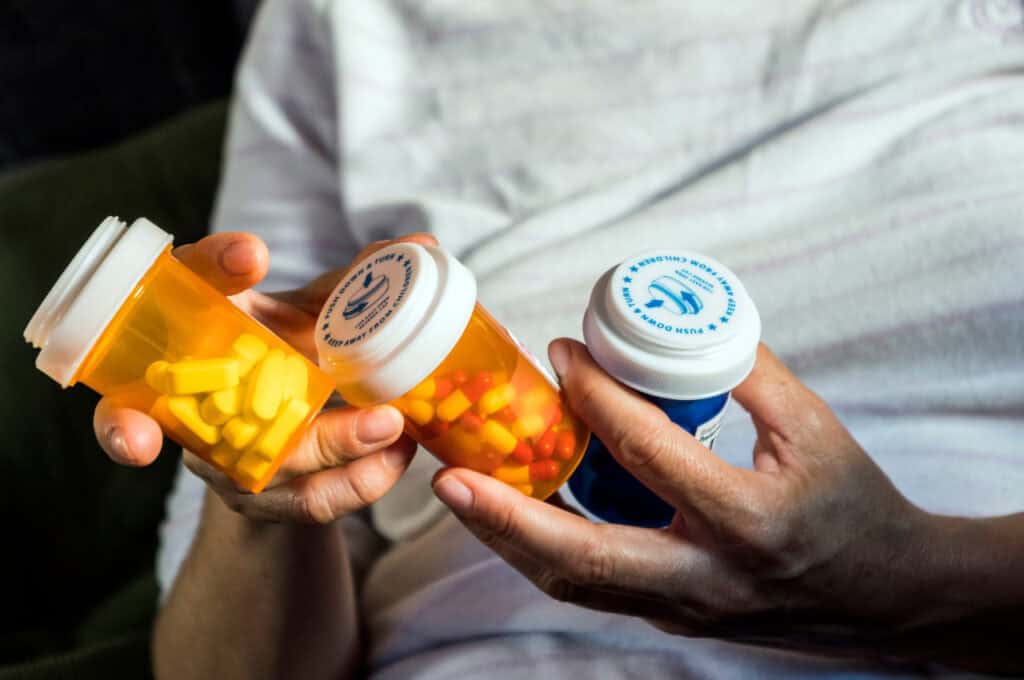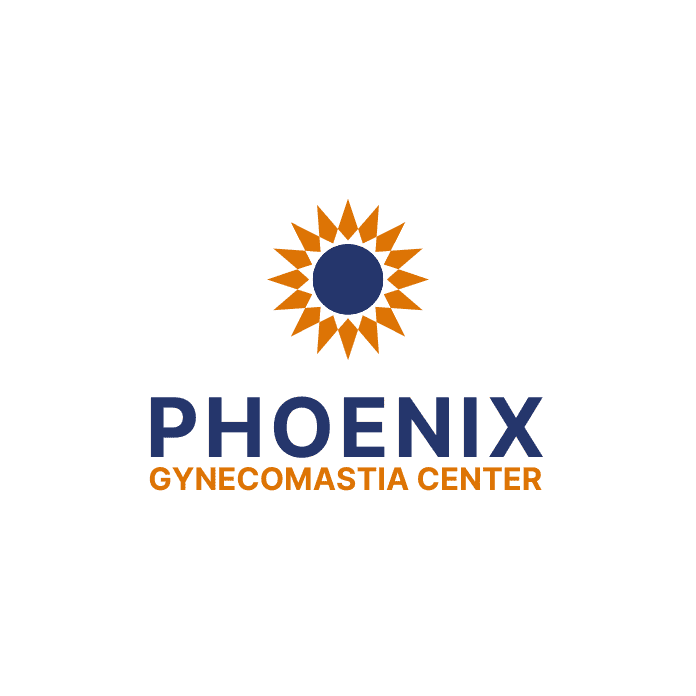Many men who visit us at the Phoenix Gynecomastia Center are concerned when they notice changes in their chest. The worry often isn’t just cosmetic. If you have started a medication recently and see swelling or tenderness in your breast area, you aren’t alone in asking whether medications could be to blame.
Some commonly prescribed medications can disrupt the hormonal balance in men and trigger gynecomastia, the enlargement of male breast tissue.
Our team is here to guide you through understanding which drugs can cause this side effect, how the process works, and what safer options may be available. Let’s explore what you need to know, so you can make fully informed decisions with your doctor.
Key Takeaways
- Gynecomastia triggers: Several common medications can contribute to male breast growth by disrupting hormone levels.
- Recognizable drug groups: Heart medications, psychiatric drugs, and some antibiotics are among those most often linked to gynecomastia.
- How drugs cause gynecomastia: Many medications can increase estrogen, decrease testosterone, or change how these hormones are processed.
- Symptoms matter: Early signs like breast tenderness, swelling, or nipple changes should prompt a review of your medications.
- Safer alternatives: Many common medications have substitutes that reduce the risk of developing gynecomastia.
- Professional monitoring: Changing medications safely requires guidance from your prescribing physician and a knowledgeable gynecomastia specialist.
- Personalized support: At the Phoenix Gynecomastia Center, you can receive a full medication review and counseling as part of your treatment plan.

Understanding Gynecomastia and Its Medication Links
Gynecomastia is the benign enlargement of male breast tissue, commonly seen in adolescents and adult men. Though a variety of conditions can lead to this condition, medication-induced gynecomastia stands out as a frequent cause.
Medication-driven gynecomastia isn’t rare. In fact, studies cite that up to 25 percent of all gynecomastia cases in adults relate to drugs or substances. The issue can be temporary or, in some cases, persist after stopping the medication.
Medication impacts can appear gradually or soon after starting a new drug. By identifying culprit medications early, you can work with your physician to reduce or reverse unwanted changes.
How Medications Cause Gynecomastia
Most medications linked with gynecomastia influence hormone balance in the body. Disrupted ratios of testosterone and estrogen often play the biggest role, but the pathways can be complex.
Some drugs block testosterone production, while others directly increase levels of estrogen or its effects on breast tissue. A smaller group causes the pituitary gland to release signals that stimulate breast growth.
To better understand this process, let’s look at three main ways medications can create hormonal changes leading to gynecomastia.
Direct Effects on Hormones
A significant number of drugs can directly lower testosterone or raise estrogen. These effects tip the hormonal balance toward breast tissue growth.
- Spironolactone, a common blood pressure medication, both blocks testosterone and increases estrogen-like effects.
- Some anti-androgens (like finasteride, used for prostate conditions and hair loss) reduce the body’s active testosterone.
Interference With Hormone Metabolism
Other medications alter how the liver processes hormones, resulting in higher available estrogen. This effect can persist as long as you take the medication.
- Cimetidine, a stomach acid reducer, is a well-known example. It decreases liver metabolism of estrogen and allows this hormone to build up.
- Certain antifungal medications such as ketoconazole also impact hormone breakdown in the liver.
Pituitary Gland Effects
A smaller subset of drugs affect signals coming from the pituitary gland. These medications increase prolactin or other hormones that encourage the growth of breast tissue.
- Some psychiatric drugs, especially risperidone, boost prolactin and lead to gynecomastia as a side effect.
Understanding which mechanism is at work is important for selecting a safer substitute if you need a medication change.
Medications Most Commonly Associated With Gynecomastia
A wide range of drugs can be implicated, but a few specific groups cause the majority of cases seen in clinical practice.
You may find it helpful to review this list, particularly if you have started any of these medications recently and noticed new breast changes.
- Antihypertensives: Drugs to treat high blood pressure such as spironolactone, calcium channel blockers (like nifedipine), and ACE inhibitors are well-known culprits.
- Heart medications: Digoxin and some beta-blockers can mimic estrogen or indirectly reduce androgen effects.
- Anti-androgens: Medications like finasteride (for prostate enlargement or hair loss) and flutamide (prostate cancer treatment) block testosterone action.
- Antipsychotics and psychiatric medications: Risperidone, haloperidol, and phenothiazines may elevate prolactin and change hormone balance.
- Antibiotics and antifungals: Metronidazole and ketoconazole may interfere with hormone production and breakdown.
- Acid reducers: Cimetidine has a particular reputation for causing breast changes in men.
- Hormone therapies: Estrogen-containing drugs and anabolic steroids (especially when abused or misused) have powerful effects on male breast tissue.
If you suspect that one of your medications could be causing symptoms, bringing a full list to your consultation can provide important clues.
Symptoms and When to Take Action
Recognizing the early signs of gynecomastia can help prevent long-term changes if you intervene in time. The sooner you identify the association, the easier it is to address.
Main Signs You May Notice
Most patients first detect a painless swelling or fullness behind the nipple. You may also notice breast tenderness or increased sensitivity when you touch the area.
Occasionally, the skin over the breast may feel firmer, and the enlarged tissue can seem rubbery or slightly mobile beneath your fingers.
Red Flags That Need Prompt Attention
If you experience one-sided breast growth, major pain, or see changes such as nipple discharge, it’s wise to contact a physician immediately. These symptoms can suggest other health issues that need urgent evaluation.
Remember that most cases from medications are bilateral (involve both sides) and develop gradually. If changes seem rapid or pronounced on just one side, do not wait to seek a specialist’s input.
When to Seek Help for Gynecomastia
If you notice changes soon after starting a new medication or adjusting your dose, do not stop taking it until you consult your prescribing doctor. Sudden medication withdrawal can carry serious health risks.
Schedule a medical evaluation if breast enlargement persists longer than two months, worsens, or causes significant emotional concern. At the Phoenix Gynecomastia Center, we offer nonjudgmental support and a detailed approach to investigating your medication history.
Even if you are unsure whether your medication is involved, documenting the start date and any symptom changes can help us pinpoint the likely cause during your visit.

Safer Medication Alternatives to Reduce the Risk of Gynecomastia
For many drugs linked to gynecomastia, alternative treatments exist. Finding an appropriate substitute should always involve collaboration between your main doctor and, if needed, a gynecomastia-focused specialist.
Let’s review a few common examples. Please note that any medication change must be supervised by your healthcare team to prevent complications.
Blood Pressure Medications
Spironolactone has a higher risk of causing breast tissue growth. Often, patients with high blood pressure can switch to equally effective medications with a lower gynecomastia risk.
Eplerenone, a related medicine, does not interfere with hormone balance as dramatically as spironolactone. Other options include thiazide diuretics, ACE inhibitors (except some rare cases), and many of the modern angiotensin II receptor blockers (ARBs).
Psychiatric Medications
Antipsychotics like risperidone may cause significant breast changes. Alternatives such as aripiprazole generally have much less impact on prolactin and androgens.
Always consult your psychiatrist before adjusting any mental health medication, since symptom control is an important consideration.
Acid Reducers
Cimetidine is notorious for causing male breast growth. Safer choices include famotidine or newer proton pump inhibitors like omeprazole, which do not disrupt hormone metabolism in the same way.
If you rely on these medications for heartburn or ulcer prevention, a transition plan can be put in place.
Finasteride and Hair Loss Treatments
Finasteride sometimes causes breast enlargement due to its impact on testosterone conversion. Alternatives include topical minoxidil, which does not affect hormones and still offers efficacy in many cases of hair loss.
You and your doctor can weigh the benefits of continuing with one treatment or exploring non-hormonal solutions.
Steps to Take If You Suspect Drug-Induced Gynecomastia
If you believe a medication is causing your breast enlargement, you can take several steps to ensure prompt evaluation and treatment.
- Gather your medication list: Include all prescription drugs, over-the-counter medications, and supplements.
- Mark when symptoms started: Check if breast changes began soon after starting a new medication or changing a dose.
- Do not stop medications abruptly: Seek medical guidance before making changes, especially with blood pressure or psychiatric medications.
- Schedule a gynecomastia evaluation: A thorough assessment by our team can help pinpoint the likely cause and rule out other health issues.
Early action can increase the chance that breast changes will resolve once the culprit medication is stopped or replaced with a safer option.
Long-Term Outlook and Management
Most medication-induced gynecomastia will improve or resolve if the offending medication is stopped within six months of the onset. When breast tissue has been enlarged for a year or longer, it can become more fibrous and less likely to shrink with conservative treatment alone.
You may still experience tenderness or noticeable fullness even after stopping the medication. In those cases, surgery is the most reliable way to achieve a flatter, masculine chest contour.
When needed, our surgeon at the Phoenix Gynecomastia Center can review all treatment options, including observation, medication adjustment, and minimally invasive procedures.
Prevention Tips
You can take several practical steps to protect yourself from developing gynecomastia as a medication side effect. Reviewing and updating your medication plan at regular intervals is one of the best measures.
Strategies for Prevention
- Open communication with your doctor: Report any new breast changes as soon as you notice them. Ensure medications are reviewed for hormonal side effects when starting long-term therapy.
- Awareness when choosing treatments: If you have a family or personal history of gynecomastia, mention this to your provider when starting new medications.
- Opt for the lowest effective dose: Using the lowest therapeutic dose can sometimes reduce the chance of hormone disruption.
- Routine follow-up: Schedule regular check-ins to assess for side effects, especially within the first three to six months of new therapy.
By practicing proactive medication management, you can minimize gynecomastia risk while still controlling other health conditions effectively.
The Role of the Gynecomastia Specialist
Having a specialist involved can mean faster diagnosis, more precise treatment plans, and the opportunity to explore both nonsurgical and surgical solutions.
During your visit, we take time to review all aspects of your medical history, medication use, and physical symptoms. This comprehensive analysis helps ensure you receive advice tailored to your unique needs.
You do not need to worry about bringing up sensitive concerns. At our Phoenix office, we regularly help men address this issue discreetly and compassionately.
Closing Thoughts
Gynecomastia may feel like an uncomfortable subject, but discussing its possible links with medication is an empowering step. When you understand which medications can cause undesirable changes and how to manage your risks, you’re better equipped to protect both your health and your confidence.
If you think a prescription medication might be contributing to changes in your chest, do not hesitate to take action. Schedule a dedicated evaluation, gather your medication list, and open the conversation with your doctor as soon as possible.
If you need more specialized support, the Phoenix Gynecomastia Center is always here to help. Our team can walk you through a full assessment, review safer alternatives with your prescribing doctor, and create a plan tailored to your goals.
Take that first step today by reaching out and scheduling your consultation.

